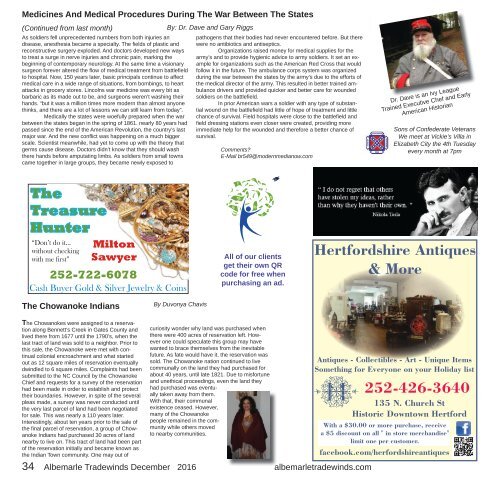Tradewinds December 2016 CC Web Final
December 2016
December 2016
You also want an ePaper? Increase the reach of your titles
YUMPU automatically turns print PDFs into web optimized ePapers that Google loves.
Medicines And Medical Procedures During The War Between The States<br />
(Continued from last month)<br />
As soldiers fell unprecedented numbers from both injuries an<br />
disease, anesthesia became a specialty. The fi elds of plastic and<br />
reconstructive surgery exploded. And doctors developed new ways<br />
to treat a surge in nerve injuries and chronic pain, marking the<br />
beginning of contemporary neurology. At the same time a visionary<br />
surgeon forever altered the fl ow of medical treatment from battlefi eld<br />
to hospital. Now, 150 years later, basic principals continue to affect<br />
medical care in a wide range of situations, from bombings, to heart<br />
attacks in grocery stores. Lincolns war medicine was every bit as<br />
barbaric as its made out to be, and surgeons weren’t washing their<br />
hands. “but it was a million times more modern than almost anyone<br />
thinks, and there are a lot of lessons we can still learn from today”.<br />
Medically the states were woefully prepared when the war<br />
between the states began in the spring of 1861. nearly 80 years had<br />
passed since the end of the American Revolution, the country’s last<br />
major war. And the new confl ict was happening on a much bigger<br />
scale. Scientist meanwhile, had yet to come up with the theory that<br />
germs cause disease. Doctors didn’t know that they should wash<br />
there hands before amputating limbs. As soldiers from small towns<br />
came together in large groups, they became newly exposed to<br />
By: Dr. Dave and Gary Riggs<br />
pathogens that their bodies had never encountered before. But there<br />
were no antibiotics and antiseptics.<br />
Organizations raised money for medical supplies for the<br />
army’s and to provide hygienic advice to army soldiers. It set an example<br />
for organizations such as the American Red Cross that would<br />
follow it in the future. The ambulance corps system was organized<br />
during the war between the states by the army’s due to the efforts of<br />
the medical director of the army. This resulted in better trained ambulance<br />
drivers and provided quicker and better care for wounded<br />
soldiers on the battlefi eld.<br />
In prior American wars a soldier with any type of substantial<br />
wound on the battlefi eld had little of hope of treatment and little<br />
chance of survival. Field hospitals were close to the battlefi eld and<br />
fi eld dressing stations even closer were created, providing more<br />
immediate help for the wounded and therefore a better chance of<br />
survival.<br />
Comments?<br />
E-Mail br549@modernmedianow.com<br />
Dr. Dave is an Ivy League<br />
Trained Executive Chef and Early<br />
American Historian<br />
Sons of Confederate Veterans<br />
We meet at Vickie’s Villa in<br />
Elizabeth City the 4th Tuesday<br />
every month at 7pm<br />
The<br />
Treasure<br />
Hunter<br />
ont do it<br />
itot cecin<br />
it me first<br />
Milton<br />
Sawyer<br />
252-722-6078<br />
Cas yer old iler eelry Coins<br />
All of our clients<br />
get their own QR<br />
code for free when<br />
purchasing an ad.<br />
ertorhre nte<br />
ore<br />
The Chowanoke Indians<br />
By Duvonya Chavis<br />
The Chowanokes were assigned to a reservation<br />
along Bennett’s Creek in Gates County and<br />
lived there from 1677 until the 1790’s, when the<br />
last tract of land was sold to a neighbor. Prior to<br />
this sale, the Chowanoke were met with continual<br />
colonial encroachment and what started<br />
out as 12 square miles of reservation eventually<br />
dwindled to 6 square miles. Complaints had been<br />
submitted to the NC Council by the Chowanoke<br />
Chief and requests for a survey of the reservation<br />
had been made in order to establish and protect<br />
their boundaries. However, in spite of the several<br />
pleas made, a survey was never conducted until<br />
the very last parcel of land had been negotiated<br />
for sale. This was nearly a 110 years later.<br />
Interestingly, about ten years prior to the sale of<br />
the fi nal parcel of reservation, a group of Chowanoke<br />
Indians had purchased 30 acres of land<br />
nearby to live on. This tract of land had been part<br />
of the reservation initially and became known as<br />
the Indian Town community. One may out of<br />
curiosity wonder why land was purchased when<br />
there were 400 acres of reservation left. However<br />
one could speculate this group may have<br />
wanted to brace themselves from the inevitable<br />
future. As fate would have it, the reservation was<br />
sold. The Chowanoke nation continued to live<br />
communally on the land they had purchased for<br />
about 40 years, until late 1821. Due to misfortune<br />
and unethical proceedings, even the land they<br />
had purchased was eventually<br />
taken away from them.<br />
With that, their communal<br />
existence ceased. However,<br />
many of the Chowanoke<br />
people remained in the community<br />
while others moved<br />
to nearby communities.<br />
34 Albemarle <strong>Tradewinds</strong> <strong>December</strong> <strong>2016</strong> albemarletradewinds.com<br />
nte - oecte - rt - ne tem<br />
omethn or Eerone on or oa t<br />
--<br />
hrch t<br />
torc onton ertor<br />
th a or more rchae recee<br />
a cont on a n tore merchane<br />
mt one er ctomer<br />
aceoocomherorhreante

















